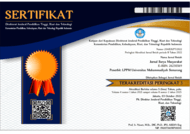Pelatihan Pembuatan Hand Sanitizer kepada Masyarakat Desa Tangguh di Kp. Pasir Honje, Ds. Sukawening Kec. Ciwidey Kab. Bandung
(1) UIN Sunan Gunung Djati Bandung
(2) UIN Sunan Gunung Djati Bandung
(3) UIN Sunan Gunung Djati Bandung
(4) UIN Sunan Gunung Djati Bandung
(5) UIN Sunan Gunung Djati Bandung
(6) UIN Sunan Gunung Djati Bandung
(7) UIN Sunan Gunung Djati Bandung
(8) UIN Sunan Gunung Djati Bandung
(*) Corresponding Author
Abstract
The Covid-19 pandemic that has been attacked almost all countries in the world since 2020 has changed the lifestyle and habits of peoples globally. Since this outbreak until now, peoples in all countries including in Indonesia must implement the health protocols to reduce the rate of virus transmission. One of them is by maintaining hand hygiene by washing hands using soap or hand sanitizer (HS). HS is used as an alternative in conditions which is difficult to washing hand. But, rural communities, especially in Tangguh Village in Kampung Pasir Honje, Sukawening, Ciwidey, Bandung Regency, are currently unable to use it due to limited access and economy. Training of making HS for the community can be a solution in overcoming this problem. Thie aims of this activity to provide skills to the people of Tangguh Village to make hand sanitizers made from alcohol and non alcohol. Method: conducted by lectures and do questions and answers about HS and then direct practice of making HS. Result: All participants can make hand sanitizers well. There are 2 types of HS that have been successfully made by the community, namely HS containing alcohol and HS free of alcohol. The alcohol content in the first type is around 60-70%, while the alcohol-free HS is made from betel leaf extract because it contains antibacterial compounds. The results of the evaluation show that 50% of the participants stated that they were very satisfied with the implementation of this activity and about 92% stated that this activity was very beneficial for them.
Keywords
Full Text:
PDFReferences
Amanda, S., Mastra, N., dan Sudarmanto, I.G. (2019). Uji Aktivitas Antibakteri Rebusan Daun Sirih (piper betle Linn) Terhadap Bakteri Streptococcus pyogenes. Meditory Vol. 7 No 1:37-43, https://ejournal.poltekkes-denpasar.ac.id/index.php/M/article/view/639
Bustanussalam, Apriasi, D., Suhardi, E., and Jaenudin D. (2015). Efektivitas Antibakteri Ekstrak Daun Sirih (Piper betle Linn) terhadap Staphylococcus aureus ATCC 25923. Fitofarmaka Vol 5 No.2: 58-64, https://journal.unpak.ac.id/index.php/fitofarmaka/article/view/409
Cirrincione, L. et al. (2020). COVID-19 Pandemic: Prevention and Protection Measures to be Adopted at the Workplace. Sustainability vol. 12, https://ideas.repec.org/a/gam/jsusta/v12y2020i9p3603-d352031.html
Desiyanto, F.A. and Djannah, S. N. (2013). Efektivitas Mencuci Tangan Menggunakan cairan pembersih tangan Antiseptik (Hand Sanitizer) Terhadap Jumlah Angka Kuman. KESMAS. Vol 7. No. 2. Pp. 55-112, http://journal.uad.ac.id/index.php/KesMas/article/view/1041/0
Dewi, D. W., Khotimah, S. Liana, D.F. (2016). Pemanfaatan Infusa Lidah Buaya (Aloe Vera L) sebagai Antiseptik Pembersih Tangan terhadap Jumlah Koloni Kuma. Jurnal Cerebellum Vol 2 No.3,http://jurnal.untan.ac.id/index.php/jfk/article/download/20022/16449
Endarini, L. H. (2016). Farmakognisi dan Fitokimia. Kementerian Kesehatan Republik Indonesia. http://bppsdmk.kemkes.go.id/pusdiksdmk/wp-content/uploads/2017/08/Farmakognisi-dan-Fitokimia-Komprehensif-1.pdf, Diakses pada tanggal 15 April 2021
Hafeez, A., Ahmad, S., Siddqui, S.A., Ahmad, M., and Mishra, S. (2020). A Review of COVID-19 (Corona Virus Disease-19) Diagnosis, Treaetments and Prevention. Eurasian Journal of Medicine and Oncology; 4(2): 116-125. https://ejmo.org/10.14744/ejmo.2020.90853/
Handayani, D., Hadi, D.R., Isbaniah, F., Brhan E., and Agustin, H. (2020). Penyakit Virus Corona 2019. Jurnal Respirologi Indonesia volume 40 nomor 2 (119-129), https://jurnalrespirologi.org/index.php/jri/article/view/101
Hapsari, D. N., hendrarini, L., dan Muryani, S. (2015). Manfaat Estrak Daun Sirih (Piper betle Linn) Sebagai Hand Sanitizer untuk Menurunkan Angka Kuman Tangan. Sanitasi Jurnal Kesehatan Lingkungan Vol 7 No 2 (79-84),https://garuda.ristekbrin.go.id/documents/detail/923221
Heyne, K. (1987). Tumbuhan Berguna Indonesia jilid III, diterjemahkan oleh Badan Litbang Kehutanan, Yayasan Sarana Wana Jaya (ID): Jakarta
Jing, Jane Lee Jia, et al. (2020). Hand Sanitizers: A Review on Formulation Aspects, Adverse Effects, and Regulations. International Journal of Environemental Research and Public Health, Vol 17. Issue 9, https://www.mdpi.com/1660-4601/17/9/3326
Kaveti, B., Tan, L., Sarnnia, Kuan, T.S., and Baig, M. (2011). Antibacterial activity of Piper Betel Leaves. International Journal of Pharmacy Teaching & Practices. Vol 2, Issue 3: 129-132, https://www.researchgate.net/publication/236592977_Antibacterial_Activity_Of_Piper_Betel_Leaves
Khafidhoh, Z., Dewi, S.S., dan Iswara, A. (2015). Efektivitas Infusa Kulit Jeruk Purut (Citrus hystrix DC.) Terhadap pertumbuhan Candida albicans Penyebab Sariawan secara in vitro. The 2nd University Research Coloquium, Prosiding Seminar Nasional dan Internasional UNIMUS, https://jurnal.unimus.ac.id/index.php/psn12012010/article/view/1548
KPCPEN (Komite Penanganan Covid-19 dan Pemulihan Ekonomi Nasional). (2021). Peta Sebaran Covid-19. https://covid19.go.id/peta-sebaran-covid19, di akses pada tanggal 12 April 2021
Lestari, P.M., dan Pahriyani, A. (2018). Pelatihan Pembuatan Hand anitizer Perasaan Buah Jeruk Nipis Bagi Guru, Siswa Siswi SMA dan SMK Mutiara 17 Agustus Kelurahan Teluk Pucung Bekasi Utara. Jurnal SEMAR Vol 6 No. 3 (20-24), https://jurnal.uns.ac.id/jurnal-semar/article/view/18094
Lubis, R.R., Marlisa dan Wahyuni, D.D. (2020). Antibacterial Activity of betle leaf (Peper betle L.) extract on inhibiting Staphylococcus aureus in Conjunctivitis Patient. Am J Clin Exp Immunol. Vol 9 (1): 1-5, https://www.ncbi.nlm.nih.gov/pmc/articles/PMC7076289/
Lusiana, R.A., et al. 2020. Edukasi Pembuatan Hand Sanitizer Berbasis Lidah Buaya pada Masyarakat Desa Harjowinangun, Grobogan. Jurnal Pengabdian Masyarakat Tabikpun. Vo.1 no. 1: 47-54, https://tabikpun.fmipa.unila.ac.id/index.php/jpkm_tp/article/download/19/10
Pratiwi, N.P.R.K., dan Muderawan, I. W. (2016). Analisis Kandungan Kimia Ekstrak Daun Sirih Hijau (Piper Betle) dengan GC-MS. Prosiding Seminar NAsional MIPA Undiksha.pp:304-310, https://ejournal.undiksha.ac.id/index.php/semnasmipa/article/view/10216
Sujono, H., Rizal, S., Purbaya, S., dan Jasmansyah. (2019). Uji Aktivitas Antibakteri Minyak Atsiri Daun Sirih Hijau (Piper betle L.) Terhadap bkateri Streptococcus pyogenes dan Staphylococcus aureus. Jurnal Kartika Kimia. 2 (1): 30-36, https://media.neliti.com/media/publications/282412-antibacterial-activity-of-the-essential-df9a80f3.pdf
Umakanthan, S. Et al. (2020). Origin, transmission, diagnosis and management of coronavirus disease 2019 (COVID-19). Postgraduade Medical jurnal volume 96. (753-758), https://pubmed.ncbi.nlm.nih.gov/32563999/
Willianti, E., Theodora, dan Parmasari, W.D. (2020). Analisa Aktivitas Antibakteri Rebusan DAun Sirih dengan Rebusan daun Kemangi Terhadap Pertumbuhan Bakteri Streptococcus mutans. Hang Tuah Medical Journal, Vol.18 No. 1: 36-46, http://journal-medical.hangtuah.ac.id/index.php/jurnal1/article/view/459
WHO (World Health Organisation). (2021). WHO Coronavirus (COVID-19) Dashboard. https://covid19.who.int/ diakses pada tanggal 12 April 2021
Article Metrics
Abstract view : 623 timesPDF - 118 times
DOI: https://doi.org/10.26714/jsm.4.1.2021.69-79
Refbacks
- There are currently no refbacks.
Copyright (c) 2021 Jurnal Surya Masyarakat

Jurnal Surya Masyarakat (JSM) is licensed under Creative Commons Attribution-NonCommercial-NoDerivatives 4.0
------------------------------------------------------------------------------------------------------------------------
Jurnal Surya Masyarakat (JSM)
p-ISSN: 2623-0364; e-ISSN: 2623-0569
Published by: Lembaga Penelitian dan Pengabdian Masyarakat (LPPM) Universitas Muhammadiyah Semarang



.jpg)







.jpg)